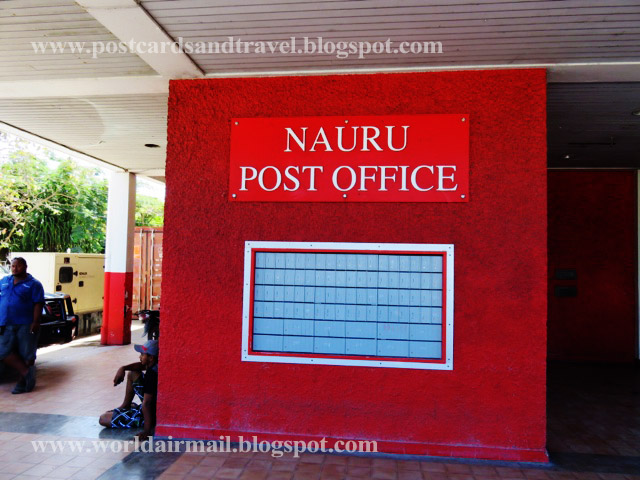Nauru (Nauruan: Naoero), officially the Republic of Nauru (Nauruan: Repubrikin Naoero) and formerly known as Pleasant
Island, is an island country in Micronesia, a subregion of Oceania, in the Central Pacific. Its nearest neighbour is Banaba Island in Kiribati, 300 km (190 mi) to the east. It further
lies northwest of Tuvalu, 1,300 km (810 mi) northeast of the Solomon Islands,[7]
east-northeast of Papua New Guinea,
southeast of the Federated States of Micronesia
and south of the Marshall Islands. With only
a 21 km2 (8.1 sq mi) area, Nauru is the third-smallest
country in the world behind Vatican City, and Monaco, making it the smallest state in the South Pacific Ocean, the
smallest state outside Europe, the smallest island state, and the
smallest republic. Additionally, its population of 10,670 is the world's third smallest, after Vatican City and Tuvalu.
Settled by people from Micronesia and Polynesia c. 1000 BC, Nauru was annexed and claimed as a colony by the German Empire in the late 19th century. After World War I, Nauru became a League of Nations mandate
administered by Australia, New Zealand and the United Kingdom. During World War II, Nauru was occupied by Japanese troops, and was bypassed by the Allied
advance across the Pacific. After the war ended, the country entered into United Nations trusteeship.
Nauru gained its independence in 1968, and became a member of the Pacific Community (SPC) in 1969. Nauru is a phosphate-rock island with rich deposits near the surface,
which allowed easy strip mining operations.
Its remaining phosphate resources are not economically viable for extraction. When
the phosphate reserves were exhausted, and the island's environment had been
seriously harmed by mining, the trust that had been established to manage the
island's wealth diminished in value. To earn income, Nauru briefly became a tax haven and illegal money laundering centre. From 2001 to 2008, and again from
2012, it accepted aid from the Australian Government in
exchange for hosting the Nauru Regional Processing
Centre, an offshore
Australian immigration detention facility. As a result of heavy
dependence on Australia, some sources have identified Nauru as a client state of Australia.
Nauru was first inhabited by Micronesians and Polynesians at least 3,000 years ago. There were traditionally
12 clans or tribes on Nauru, which are represented in the twelve-pointed star
on the country's flag. Traditionally, Nauruans
traced their descent matrilineally. Inhabitants practised aquaculture: they caught juvenile ibija fish, acclimatised them to freshwater, and raised them in the Buada Lagoon, providing a reliable source of food. The other
locally grown components of their diet included coconuts and pandanus fruit. The name
"Nauru" may derive from the Nauruan word Anáoero, which means 'I go to the beach'
As part of German Marshall Islands
Protectorate, the first post office on the island opened in 1905 using stamps
of German Marshall Islands. Following the outbreak of World War I, Nauru was
occupied by Australian forces and Australian stamps overprinted North West Pacific
Islands were used from 1914 to 1916. The British government then took control
of the island and British stamps overprinted NAURU were issued in October 1916.
From 1924, stamps were issued for Nauru as a mandated territory, then
as a trust territory after WWII.
The first stamps of independent Nauru were issued in 1968.
These are the newly received covers from Nauru, with new postmarks. Nauru restarted its postal services and EMS services too, but the registered mail services not yet started. The Marketing Manager of Nauru Post Corporation said, the Registered mail services will start soon, but not decided exactly when it will be. The postage rate hiked upto 150% than before, especially for airmail letters.
One of the most rarest country among philatelists and cover collectors finally reached in my collection. Nauru had a very good philatelic service and philatelic bureau in earlier days. Now the country has no much interest in philately and even no Registered mail service too. Mr.David visited Nauru in April 2016, and he discussed with philatelic bureau staff too. He posted the covers from Nauru and it reached in my hands on July 26, 2016.
This is Nauru Post Office ! Nauru post office looks like it was falling apart. The last stamp issue they have was released in 2009 and they have no new issues here since then. The post office sells Definitives unless you ask for special stamps and then they produce a full selection in another folder . It is just 70c to mail a postcard. They have stopped the registered service over a year ago according to June who was in charge of Nauru Post.
David and the Nauru Post Staff. Here you can see my covers are on the top of the table.








No comments:
Post a Comment
Note: only a member of this blog may post a comment.